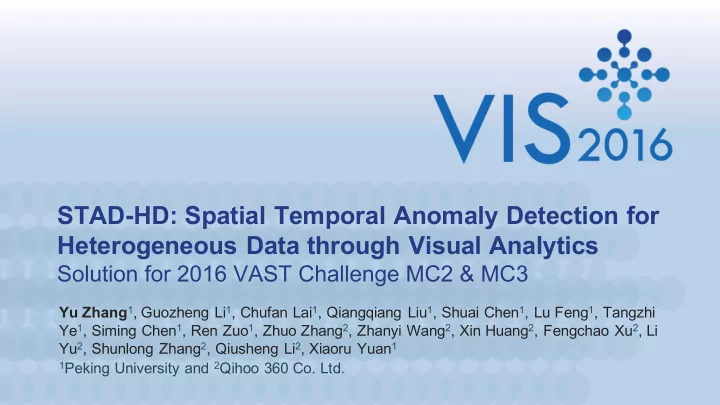

STAD-HD: Spatial Temporal Anomaly Detection for Heterogeneous Data through Visual Analytics Solution for 2016 VAST Challenge MC2 & MC3 Yu Zhang 1 , Guozheng Li 1 , Chufan Lai 1 , Qiangqiang Liu 1 , Shuai Chen 1 , Lu Feng 1 , Tangzhi Ye 1 , Siming Chen 1 , Ren Zuo 1 , Zhuo Zhang 2 , Zhanyi Wang 2 , Xin Huang 2 , Fengchao Xu 2 , Li Yu 2 , Shunlong Zhang 2 , Qiusheng Li 2 , Xiaoru Yuan 1 1 Peking University and 2 Qihoo 360 Co. Ltd.
Outline • Data description • System introduction • Cases • Conclusion 2
Data description • GAStech company moved to a three-storey building • 125 employees • 41 energy zones vs. 23 prox zones • 14 days’ static data + 60 hours’ streaming data 3
Data description • Building data • Energy zone (≤12 attributes) • Floor (≤11 attributes) • Building (16 attributes) • Prox data • Mobile sensor • Fixed sensors 4
Data description • Prox data Prox zone Robot Prox card 5
Data description • Prox data Prox-zone detection Robot detection Time: Accurate Time: Inaccurate Position: Inaccurate Position: Accurate 6
Task • Typical patterns • Notable anomalies • Relationships between two types of data 7
Task • Typical patterns • Notable anomalies • Relationships between two types of data • Design requirement: spatial and temporal filters 8
Task • “Pattern” • “Anomaly” • Not well-defined 9
Work flow 10
Work flow • Two systems • System A (Labelling System) • Basic visualizations + labelling • Store insight of the data • System B (Analysis System) • Exploits the insight from system A to reduce the ambiguity of the tasks • Anomaly-detection as entrance 11
System A: Time Series Interface Spatial filter Attribute filter 12
Time Series Interface System A Insight 1: Curves in weekdays differs from that in weekends Insight 2: Periodical pattern in weekdays Anomaly detection metric: template of a weekday (show anomaly) System B 13
System B: Time Series Interface Attribute filter Spatial filter Anomaly detection Temporal filter 14
System B: Warning Stack • Store all the anomalies with the metadata <time, position, attribute> 15
System A: Trajectory Interface All the defined labels Cross filters Labels of one trajectory 16
Trajectory Interface System A Insight 1: Physically impossible events / suspicious events Design requirement 1: Give warnings (show anomaly) Insight 2: Meeting events Design requirement 2: Directly visualize the meeting (show pattern) System B 17
Trajectory Interface Anomaly detection metric: 1. Move between zones that are not adjacent - Strong 2. Conflict between two trajectory data source - Strong 3. Staying in a zone that contains neither the office of System A the employee nor public area - Weak Insight 1: Physically impossible events / suspicious events Design requirement 1: Give warnings (show anomaly) Insight 2: Meeting events Design requirement 2: Directly visualize the meeting (show pattern) System B 18
System B: Trajectory Interface Spatial filter Trajectory simulation Gantt chart 19
System B: Trajectory Interface • Data source • Fixed prox sensor - spatial uncertainty • Mobile prox sensor - temporal uncertainty • Uncertainty reduction • Robot detection • Stay in office • Stay in public areas (e.g. meeting room) • Stay in the corridor 20
System B: Streaming Data Interface 21
System B: Streaming Data Interface Position-centric glyphs Attribute-centric glyphs Gantt Chart 22
Case 1: Shifts 23
Case 2: Meetings Information technology and engineering meet at Mtg/Training (2700) Facilities meet at Conf (2365) 24
Case 3: Lost card Lost card used New card 25
Case 4: Server Room down time Equipment power goes down Air temperature goes up Cooling setpoint goes up 26
Conclusion • STAD-HD: twin systems for specifying and visualizing patterns and anomalies in heterogeneous dataset • Labelling System for insight + Analysis System for answers • Drawbacks • Labelling System cannot automatically generate insights • Transformation from insight to design requirements and finally to implementation is not automatic • Analysis System reports many false positives 27
Acknowledgement • Funding • NSFC No. 61170204 • NSFC Key Project No. 61232012 • National Program on Key Basic Research Project (973 Program) No. 2015CB352500 • Reviewers • Anonymous Reviewers 28
Thank You 29
Recommend
More recommend